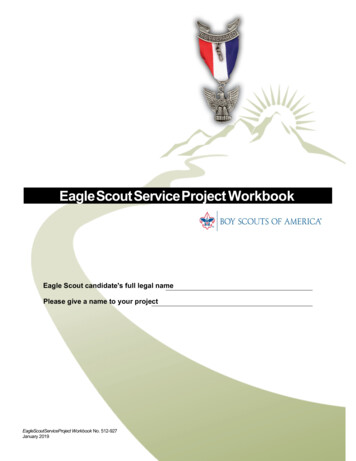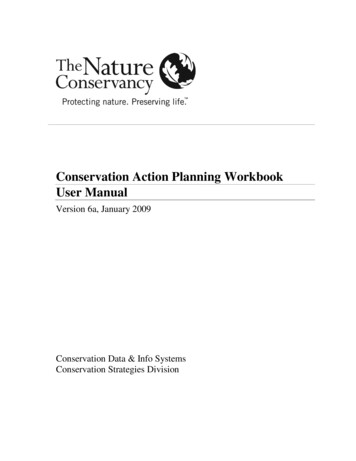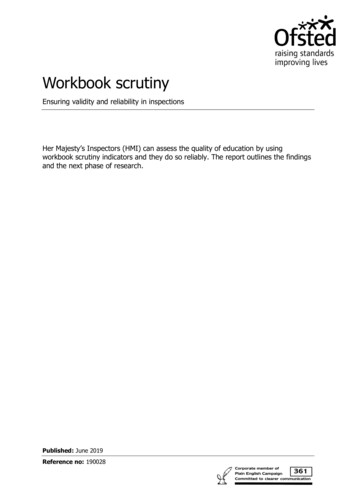
Transcription
Eagle Scout Service Project WorkbookEagle Scout candidate's full legal namePlease give a name to your projectEagleScoutServiceProject Workbook No. 512-927January 2019
Message From the Chief Scout ExecutiveGreetings Eagle Scout Candidate!Congratulations on earning the rank of Life Scout. You are amongapproximately 55,000 youth who year after year, achieve thatimportant milestone. As you ponder the meaning behind the Life patch, Iencourage you to think about the symbol of the heart. Historically inScouting, it was a fitting symbol of health and fitness, but it alsorepresents the spirit of caring and giving that’s behind the Eagle Scoutservice project.Service to other people is what Scouting is all about. In many ways, yourservice project is a reflection of who you are as a youth leader. Your resultshould be of significant impact in your community to be special, andshould represent your very best effort.Your proposal, the logical first step, should emphasize your intention togive leadership to others through proper planning and development. Communicate with the beneficiaryoften to ensure the project meets the organization’s needs once it’s completed.I encourage you to seek guidance from your unit leader and project coach as you need help. Your EagleScout Service Project Workbook, much like a compass, will help navigate your way to a life of service as a proudEagle Scout.Wishing you all the best in your journey on the Trail to Eagle!Michael B.SurbaughChief Scout ExecutiveScouts and Parents or GuardiansPlease read "Message to Scouts and Parents or Guardians” on pages 5 and 6. This includes excerpts and summaries from theGuide to Advancement that may help ensure requirements are properly administered according to national BSA policies andprocedures. Please note, also, that when Eagle Scout candidates submit their project proposal they will promise they haveread this entire workbook. Doing so will be important to their success.Only the Official Workbook MayBe UsedEagle Scout candidates must use the official Eagle Scout Service Project Workbook, No. 512-927, as produced by the BSA andfound at www.scouting.org/advancement. Although it is acceptable to copy and distribute the workbook, no council, district,unit, or individual has the authority to produce or require additional forms, or to add or change requirements, or to make anyadditions, deletions or changes in the text, outlines, links, graphics, or any other elements of the workbook.Attention: Unit, District, and Council ReviewersEagle Scout projects must be evaluated primarily on impact—the extent of benefit to the religious institution, school, orcommunity, and on the leadership provided by the candidate. There must also be evidence of planning and development.This is not only part of the requirement but relates to practicing the Scout motto, Be Prepared. However, in determining if aproject meets Eagle Scout requirement 5, reviewers must not require more planning and development than necessary toexecute the project. These elements must not overshadow the project itself, as long as the effort was well led and resulted inotherwise worthy results acceptable to the beneficiary.Page 2
ContentsEagle Scout Service Project Workbook2Message from the Chief Scout ExecutiveHow to Use This Workbook34Meeting Eagle Scout Requirement 54Eagle Scout Requirement 54Project Purpose4Choosing a Project4Restrictions and Other Considerations4Collecting Service Project Data5Message to Scouts and Parents or Guardians6Excerpts and Summaries from the Guideto AdvancementWorkbook FormsEagle Scout Service Project ProposalInstructions for Preparing Your ProposalContact InformationEagle Scout Service Project PlanEagle Scout Service Project Fundraising ApplicationProcedures and Limitations on Eagle Scout Service Project FundraisingEagle Scout Service Project ReportNavigating the Eagle Scout Service Project, Information for Project BeneficiariesHow to Use This WorkbookThis workbook includes valuable information that can help ensure your success. It includes four project forms: a proposal, a plan,a fundraising application, and a report. Following the project report you will find “Navigating the Eagle Scout Service Project,” aninformation sheet that you should provide to the project beneficiary before the beneficiary approves your proposal. You will findit helpful to take the entire workbook—even the parts that have not yet been prepared—with you to all meetings anddiscussions concerning your project.Before preparing any of the four forms, read with your parent or guardian, the “Message to Scouts and Parents or Guardians”found on pages 5 and 6. If your project is worthy and meets Eagle Scout requirement 5 as written, the message will help yousuccessfully present your proposal through the approval process.Preparing the Project ProposalGo to Project ProposalYour proposal must be completed first. It is an overview, but also the beginnings of planning. Be sure to read “Instructions forPreparing Your Proposal” which appears right after the proposal cover page in this workbook.The Project PlanGo to Project PlanPrepare your project plan after your proposal has been approved, but before you begin work on your project. The Project Planform is a tool for your use. No one approves it, although your project beneficiary has the authority to review it and requirechanges in it. Your project plan can also be important in showing your Eagle Scout board of review that you have planned anddeveloped your project as required. And you are strongly encouraged to share your project plan with an Eagle Scout serviceproject coach. Doing so can help you avoid many problems associated with service projects. Be sure to check with the council ordistrict person who approved your proposal to learn how project coachesare designated in your community.The Fundraising ApplicationGo to Fundraising ApplicationIf your fundraising effort involves contributions only from the beneficiary, or you, your parents or relatives, your unit or itschartered organization, or parents or members in your unit, then you do not need a fundraising application. If you will beobtaining money, materials, supplies, or donations from other sources, you may need to submit an application. See “Proceduresand Limitations on Eagle Scout Service Project Fundraising,” which appears on page B of the fundraising application.The Project ReportGo to Project ReportPrepare the project report after the project has been executed. You must sign it to confirm you led and executed the project.Note also, the signature lines for the beneficiary's and your unit leader's approval that your project fulfilled Eagle Scoutrequirement 5.Page 3
Meeting Eagle Scout Requirement 5Eagle Scout Requirement 5WhileaLifeScout, plan, develop, and giveleadership toothersin aserviceproject helpful to any religious institution, anyschool,or your community. (Theproject must benefit an organization other than theBoyScoutsof America)A project proposal must beapproved by theorganization benefiting from theeffort, your unit leader and unit committee, and thecouncil or district beforeyoustart.You must usetheEagle Scout Service Project Workbook,No. 512-927, in meeting thisrequirement.Project PurposeIn addition to providing service and fulfilling the part of the Scout Oath, “To help other people at all times,” one of theprimary purposes of the Eagle Scout service project is to learn leadership skills, or to improve or demonstrate leadershipskills you already have. Related to this are important lessons in project management and taking responsibility for asignificant accomplishment.Choosing a ProjectYour project must be for any religious institution, any school, or your community. It is important to note, however, that theBSA has defined “your community” to include the “community of the world.” Normally, “your community” would not referto individuals, although a council or district advancement committee may consider scenarios in which an individual in needcan affect a community. It is then a matter of identifying a source representing the “community” who will provideapprovals. For more information, see the Guideto Advancement, No. 33088, topic 9.0.2.5.Your project must present an opportunity for planning, development, and leadership. For example, if a blood drive ischosen and the blood bank provides a set of “canned” instructions to be implemented with no further planning, theplanning effort would not meet the test. You may need to meet with blood bank officials and work out an approach thatrequires planning, development, and leadership. This might involve developing and carrying out a marketing and logisticsplan, reaching a challenging collection goal, or coordinating multiple blood collection events.An Internet search can reveal hundreds of service project ideas. Your project does not have to be original, but it could be. Itmight be a construction, conservation, or remodeling project, or it could be the presentation of an event with a worthwhilepurpose. Conversations with your unit leader, teachers, your religious leader, or the leaders of various communityorganizations can also uncover ideas. In any case, be sure the project presents a challenge that requires leadership, but alsosomething that you can do with unskilled helpers, and within a reasonable period of time.Restrictions and Other Considerations There are no required minimum hours for a project. No one may tell you how many hours must be spent on it. Routine labor is not normally appropriate for a project. This might be defined as a job or service you may provide as partof your daily life, or a routine maintenance job normally done by the beneficiary (for example, pulling weeds on thefootball field at your school). While projects may not be of a commercial nature or for a business, this is not meant to disallow work for communityinstitutions, such as museums and service agencies (like homes for the elderly, for example), that would otherwise beacceptable. Some aspect of a business operation provided as a community service may also be considered; for example,a park open to the public that happens to be owned by a business, but primarily benefits the community. A project may not be a fundraiser. In other words, it may not be an effort that primarily collects money, even for a worthycharity. Fundraising is permitted only for securing materials and facilitating a project, and it may need to be approved byyour council.See “EagleScout Service Project Fundraising Application” later in this workbook. No more than one EagleScout candidate may receive credit for working on the sameEagleScout service project. Projects must not be performed for the Boy Scouts of America, or its councils, districts, units, or properties.Collecting Service Project DataThe BSA collects information on hours worked on Eagle Scout projects because it points to achievement of our citizenshipaim. Please assist with data collection by keeping a list of people who help and the number of hours they work. When youprepare your project report you will need to include this data on page B of the report. Providing accurate information willalso help your unit leadership enter your project into the BSA’sJourney to Excellence tracking system.Page 4
Message to Scouts and Parents or GuardiansThe Eagle Scout service project requirement has been widely interpreted—both properly and improperly. This message is designed toshare with you, the Eagle Scout candidate, and your parents or guardians the same information BSA provides to council and districtvolunteers responsible for project proposal approvals throughout the Boy Scouts of America.In addition to reading this entire workbook, you and your parents or guardians should consult the Guide to Advancement, No. 33088,beginning with topic 9.0.2.0, “The Eagle Scout Service Project.” The Guide may be accessed at www.scouting.org/advancement.The current Guide to Advancement, No. 33088, along with the Scouts BSA Requirements book, No. 33216, and this workbook, are theprimary official sources on policies and procedures for Eagle Scout service projects. The Guide to Advancement and Scouts BSARequirements book are available in Scout shops or on www.scoutshop.org. Your local council and district are important resources forinformation and guidance and can tell you where to submit service project proposals.The council and district may also establish limited local procedures as necessary. However, all of this must be done in harmony with theofficial sources mentioned above. Councils, districts, units, and individuals must not add requirements or ask you to do anything thatruns contrary to, or that exceeds, the policies, procedures, or requirements of the Boy Scouts of America.Available from your Scout Shop or on www.scoutshop.org is an Eagle Project plaque to place at your project location at the completionof the project /6831).What an Eagle Scout Candidate Should ExpectThe Eagle Scout service project belongs to the Eagle Scout candidate. The candidate's parents and others may help, butthe Scout must be the leader. Nonetheless, while working toward completion of the project, especially during the proposalapproval process, a candidate has the right to expect the following, as reprinted from the Guide to Advancement, topic9.0.2.1.1. Questioning and probing for their understanding of the project, the proposal, and what must be done, shall beconducted in a helpful, friendly, courteous, and kindhearted manner. We will respect the Scout’s dignity. Scouts will beallowed, if they choose, to have a parent, unit leader, or other adult present as an observer at any time while they arediscussing their proposal or project with someone who is reviewing it.2. Project expectations will match Eagle Scout requirement 5, and we will not require proposals to include more thandescribed in the Eagle Scout Service Project Workbook.3. If requested by the Scout or the Scout's parent or guardian, an explanation of a proposal rejection will be provided inwriting, with a copy sent to the council advancement chair and staff advisor. It will indicate reasons for rejection andsuggestions concerning what can be done to achieve approval.4. Guidance that maximizes the opportunity for completion of a worthwhile project will be readily available and stronglyrecommended. Ultimately, however, the responsibility for success belongs to the Scout, and final evaluation is left tothe board of review.5. Candidates who believe they have been mistreated or their proposal wrongfully rejected, will be provided a methodof redress. This will include the opportunity for a second opinion and approval, either through another volunteer orprofessional advancement administrator*, or the Scout executive, as determined by the council advancementcommittee or executive board.*An "advancement administrator" is a member or chair of a council or district advancement committee, or a volunteer or professionaldesignated according to local practices, to assist in advancement administration.Page 5
Excerpts and SummariesFrom the Guide toAdvancementEagle Scout Service Project Coaches (See the Guide toAdvancement, topic 9.0.2.9)Many units, districts, and councils use Eagle Scout service project “coaches,” because the advice they provide after approval of aproposal can be invaluable as candidates develop their project plan. A coach can help Scouts see that if a plan is not sufficientlydeveloped then projects can fail. Assistance can come through evaluating a plan and discussing its strengths, weaknesses, andrisks, but coaches do not have the authority to dictate changes, or take any other such directive action. Instead, coaches must usethe BSA method of positive adult association, logic, and common sense to help the candidate make wise decisions.It is up to the council to determine who may serve as project coaches and how they might be assigned or otherwise provided tocandidates. Coaches must be registered with the BSA (in any adult position) and be current in BSA Youth Protection training, andmay come from the unit, district, or council level. For examples of how a service project coach can assist, please see the Guide toAdvancement, topic 9.0.2.9. Note that there should be only one coach that is designated for you by your council or district; butyour unit may also provide people to coach you.What Is Meant by “Give Leadership to Others ?” (See the Guide toAdvancement, topic 9.0.2.4)“Others” means at least two people besides the Scout. Helpers may be involved in Scouting or not, and of any age appropriate forthe work. Councils, districts, and units shall not establish requirements for the number of people led, or their make-up, or for timeworked on a project.Evaluating the Project After Completion (See the Guide toAdvancement, topic 9.0.2.13)Eagle Scout projects must be evaluated primarily on impact—the extent of benefit to the religious institution, school, orcommunity, and on the leadership provided by the candidate. There must also be evidence of planning and development. This isnot only part of the requirement, but relates to our motto to, “Be Prepared.” However, in determining if a project meetsrequirement 5, reviewers must not require more planning and development than necessary to execute the project. Theseelements must not overshadow the project itself, as long as the effort was well led, and resulted in an otherwise worthy outcomeacceptable to the beneficiary.There may be instances where, upon its completion, the unit leader or project beneficiary chooses not to approve a project. Oneor the other may determine, for example, that modifications were so significant that the extent of the service or impact of theproject was insufficient to warrant approval. The candidate may be requested to do more work or even start over with anotherproject. The candidate may choose to meet these requests, or may decide —if he or she believes the completed project worthyand in compliance—to complete an Eagle Scout Rank Application and submit the project workbook without final approval. Ifrequested, the candidate must be granted a board of review. If it is thought a unit board may not provide a fair hearing, a boardof review under disputed circumstances may be initiated according to the Guideto Advancement, topic 8.0.3.2.Risk Management and Eagle Scout Service Projects (See the Guide toAdvancement, topic 9.0.2.14)All Eagle Scout service projects constitute official Scouting activity and thus are subject to Boy Scouts of America policies andprocedures. Projects are considered part of a unit's program and are treated as such with regard to policies, procedures, andrequirements regarding Youth Protection, two-deep leadership, etc. The health and safety of those working on Eagle projectsmust be integrated into project execution. Since an Eagle Scout service project is a unit activity, unit leadership has the sameresponsibility to assure safety in conducting a project as with any other unit activity. The unit leader or unit committee shouldreject proposals for inherently unsafe projects. The candidate should plan for safe execution, but it must be understood thatminors cannot and must not be held responsible for safety concerns. As with any Scouting activity, the Guide to Safe Scoutingapplies. The “Sweet 16 of BSA Safety” must also be consulted as a planning tool. It can be found at: et16/. The GuidetoSafeScouting may be accessed at surance and Eagle Scout Projects (See the Guide toAdvancement, topic 9.0.2.15)The Boy Scouts of America General Liability Policy provides general liability insurance coverage for official Scouting activities.Registered adult leaders are provided primary coverage. Unregistered adults participating in a Scouting activity are providedcoverage in excess of their personal insurance. Every council has the opportunity to participate in the BSA Accident and Sicknessinsurance program. It provides some insurance for medical and dental bills arising from Scouting activities. If councils do notpurchase this, then units may contract for it. In some cases, chartered organizations might provide insurance, but this must notbe assumed. Most of these programs provide only secondary coverage, and are limited to registered youth and adults and thoseinterested in becoming members.Page 6
Eagle Scout Service Project ProposalEagle Scout candidate's full legal nameEagle Scout Service Project NameEagle Scout Requirement 5While a Life Scout, plan, develop, and give leadership to others in a service project helpful to any religiousinstitution, any school, or your community. (The project must benefit an organization other than the Boy Scouts ofAmerica.) The project proposal must be approved by the organization benefiting from the effort, your unit leaderand unit committee, and the council or district before you start. You must use the Eagle Scout Service ProjectWorkbook, No. 512-927, in meeting this requirement.EagleScoutServiceProject Workbook No. 512-927January 2019
Instructions for Preparing Your ProposalMeeting the Five Testsof an Acceptable Eagle Scout Service ProjectYour proposal must be prepared first. It isan overview, but also the beginnings of planning. It must show your unit leader,unit committee, and council or district that your project can meet the following tests.1. It providessufficient opportunity to meet the Eagle Scout service project requirement.You must show thatplanning, development, and leadership will take place; and how the three factors will benefit a religiousinstitution, aschool, or your community.2. It appears to be feasible. You must show the project is realistic for you to carry out.3. Safety issueswill be addressed.You must show you have an understanding of what must be done to guardagainst injury, and what will be done if someone gets hurt.4. Actionsteps for further detailed planning are included.You must make a list of the key steps you will take tomake sure your plan will have enough detailsso it can be carried out successfully.5. You are on the right track with a reasonablechance for a positive experience.When completing your proposal you only need enough detail to show a reviewer that you can meet the tests above. Ifshowing that you meet the tests requires a lengthy and complicated proposal, your project might be more complex thannecessary.Remember, the proposal is only the beginnings of planning. Most of your planning will come with the next step,preparation of your project plan.If your project does not require materials or supplies, etc., simply mark those spaces “not applicable.” As a reminder, do notbegin any work, or raise any money, or obtain any materials, until your project proposal has been approved.Consider also, that if you submit your proposal too close to your 18th birthday, it may not be approved in time to finishplanning and executing the project.Working with Your Project BeneficiaryOn the last two pages of this workbook there is an information sheet called, “Navigating the Eagle Scout Service Project.”This is for you to print and give to the religious institution, school, or community that will benefit from your efforts. Youshould do this as part of your first meeting with your beneficiary and use the sheet to help explain how the Eagle Scoutservice project works.Be sure to read it carefully so you can explain what it says.“Navigating the Eagle Scout Service Project” will help you communicate a number of things to your beneficiary. Forexample, it provides thanks and congratulations for accepting the project; and it gives some background, discusses therequirements, and points out the responsibilities connected with approving your project proposal. It also explains that thebeneficiary has the right to review, and also to require changes in your project plan.Again, be sure to read carefully “Navigating the Eagle Scout Service Project” so you will have a full understanding of therole of your beneficiary.Next Step: Your Project PlanOnce your proposal is approved, you are strongly encouraged to prepare your project plan using the form in thisworkbook. Doing so increases the likelihood your project will be approved at your Eagle Scout board of review. As youbegin preparing it, you should meet with a project coach. Check with the person who handled the approval of your projectproposal to learn how coachesare designated in your community.Your designated coach can help you avoid the common pitfalls associated with Eagle Scout service projects and be a bigpart of your success. You may also want to talk to your unit leader. There may be adults in your troop who are experts inconducting the kind of project you are planning. It's ok for you to work with them as well. The more coaching you get, thebetter your results will be.Beginning Work on Your ProjectOnce your proposal has been fully approved and you have finished your project planning, only then, may you begin workon your project.Proposal PageA
Contact InformationEagleScout candidatesshould know who is involved, but contact information may bemore important to unit leadersand othersincase they want totalk to oneanother.While it isrecognized that not all theinformation will beneeded forevery project,Scoutsareexpected to provideasmuch asreasonably possible.Approval representativesmust understand, however, that doingso isnot part of theserviceproject requirement.Eagle Scout CandidateName:Email address:Address:Preferred telephone(s):City:* BSAPIDNo., found on theBSA membership cardCurrent Unit InformationTroopCheck one:CrewShipName:Address:Email address:Unit Committee ChairName:Address:Email address:Zip:Unit Number:Name of District:Unit Leader Check one:Birth date:BSA PID number*:State:Life board of review date:Name of Council:ScoutmasterCrew AdvisorSkipperPreferred telephone(s):City:State:Zip:Preferred it Advancement Coordinator(If your unit hasone)Name:Address:Email address:Preferred telephone(s):City:Project Beneficiary (Nameof religious institution,school, or community)Preferred telephone(s):City:Name:Address:Email address:Project Beneficiary Representative (Nameof contact person for theproject beneficiary)Name:Address:Email address:Preferred telephone(s):City:Your Council Service CenterContact name:Address:State:Zip:State:Zip:Preferred telephone(s):City:Council or District Project Approval Representative(Your unit leader, unit advancement coordinator, or council or district advancement chair may help you learn who this will be.)Name:Preferred telephone(s):Address:City:State:Zip:Email address:Project Coach (Your council or district project approval representativemay helpyou learn who thiswill be.)Name:Address:Email address:Proposal PagePreferred telephone(s):City:BState:Zip:
Project Description and BenefitBriefly describe your project.Attach sketches or "before" photographs if these will help others visualize the project.Please click below to add images (JPEG, JPG, BMP, GIF, TIF, PNG, etc.)xClick above box to add an image. Click here to add animage caption.xClick above box to add an image. Click here to add animage caption.Add Additional Image FieldTell how your project will be helpful to the beneficiary. Why is it needed?When do you plan to begin carrying out your project?When do you think your project will be completed?Giving LeadershipApproximately how many people will be needed to help on your project?Where will you recruit them (unit members, friends, neighbors, family, others)?Explain:What do you think will be most difficult about leading them?MaterialsMaterialsare things that becomepart of thefinished project,such aslumber, nails, and paint.What types of materials, if any, will you need?You do not need a detailed list or exact quantities, but you must show you have areasonable idea of what is required. For example, for lumber, include basic dimensionssuch as 2 x 4 or 4 x 4.SuppliesSuppliesare thingsyou useup,such asfood and refreshments, gasoline, masking tape, tarps,safetysupplies, and garbagebags.What kinds of supplies, if any, will you need? You do not need a detailed list or exact quantities, but you must show you have areasonable idea of what is required.Proposal PageC
ToolsInclude tools, and alsoequipment, that will beborrowed, rented, or purchased.What tools or equipment, if any, will you need?You do not need a detailed list, but you must show you have a reasonable idea ofwhat is required.Other NeedsItemsthat don’t fit theabovecategories; forexample, parking or postage, orservicessuch asprinting or pouring concrete,etc.What other needs do you think you might encounter?Permits and PermissionsNotethat property ownersshould obtain and pay for permits.Will permissions or permits (such as building permits) be required for your project?Who will obtain them? How long will it take?Preliminary Cost EstimateYou do not need exact costsyet.Reviewers will just want tosee if you can reasonablyexpect to raiseenough money tocover an initial estimateofexpenses.Include thevalueof donated material,supplies, tools, and other items.It isnot necessary to include thevalueof toolsor other itemsthat willbeloaned at no cost.Notethat if your project requiresa fundraising application, you do not need tosubmit it withyour proposal.Enter estimated expenses below:(Includesales tax if applicable)Fundraising: Explain how you will raise the money to pay for the total costs. If you intend to seekdonations of actual materials, supplies, etc., then explain how you plan to do that, too.Materials:Supplies:Tools:Other:Total costs:Project PhasesThink of your project in terms of phases, and list what they might be. The first may be to prepare your project plan. Other phasesmight include fundraising, preparation, execution, and reporting. You may h
Scout Service Project Workbook, much like a compass, will help navigate your way to a life of service as a proud Eagle Scout. Wishing you all the best in your journey on the Trail to Eagle! Michael B.Surbaugh Chief Scout Executive Scouts and Parents or Guardians Pleaseread "Message to Scouts andParents or Guardians" on pages 5 and 6.










